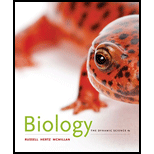
Biology: The Dynamic Science (MindTap Course List)
4th Edition
ISBN: 9781305389892
Author: Peter J. Russell, Paul E. Hertz, Beverly McMillan
Publisher: Cengage Learning
expand_more
expand_more
format_list_bulleted
Concept explainers
Question
Chapter 54.3, Problem 3SB
Summary Introduction
To review:
The mechanism of the global nitrogen cycle and the organisms that drive it.
Introduction:
Nitrogen is an important inorganic element present in the body of living organisms and is a constituent of basic proteins, DNA (deoxyribonucleic acid), and enzymes. High amount of nitrogen concentration is present in the earth’s atmosphere and nitrogen cycles operate to recycle the nitrogen from an atmospheric pool, to smaller pools and living organisms.
Expert Solution & Answer
Want to see the full answer?
Check out a sample textbook solution
Students have asked these similar questions
What is the structure and function of Eukaryotic cells, including their organelles? How are Eukaryotic cells different than Prokaryotic cells, in terms of evolution which form of the cell might have came first? How do Eukaryotic cells become malignant (cancerous)?
What are the roles of DNA and proteins inside of the cell? What are the building blocks or molecular components of the DNA and proteins? How are proteins produced within the cell? What connection is there between DNA, proteins, and the cell cycle? What is the relationship between DNA, proteins, and Cancer?
Why cells go through various types of cell division and how eukaryotic cells control cell growth through the cell cycle control system?
Chapter 54 Solutions
Biology: The Dynamic Science (MindTap Course List)
Ch. 54.1 - In the generalized compartment model of...Ch. 54.1 - Prob. 2SBCh. 54.1 - Prob. 3SBCh. 54.2 - What is the difference between gross primary...Ch. 54.2 - What environmental factors influence rates of...Ch. 54.2 - Why is energy lost from an ecosystem at every...Ch. 54.2 - Prob. 4SBCh. 54.3 - Prob. 1SBCh. 54.3 - Prob. 2SBCh. 54.3 - Prob. 3SB
Ch. 54.3 - What is Earths main reservoir for phosphorus, and...Ch. 54.4 - Prob. 1SBCh. 54.4 - Prob. 2SBCh. 54.4 - Prob. 3SBCh. 54 - Prob. 1TYKCh. 54 - The total dry weight of plant material in a forest...Ch. 54 - Prob. 3TYKCh. 54 - Prob. 4TYKCh. 54 - Which process moves nutrients from the available...Ch. 54 - Which of the following materials has a sedimentary...Ch. 54 - Prob. 7TYKCh. 54 - Prob. 8TYKCh. 54 - The amount of energy available at the highest...Ch. 54 - Which of the following statements is supported by...Ch. 54 - Prob. 11TYKCh. 54 - Prob. 12TYKCh. 54 - Prob. 13TYKCh. 54 - Prob. 14TYKCh. 54 - Prob. 15TYKCh. 54 - Prob. 16TYKCh. 54 - Prob. 1ITD
Knowledge Booster
Learn more about
Need a deep-dive on the concept behind this application? Look no further. Learn more about this topic, biology and related others by exploring similar questions and additional content below.Similar questions
- In one paragraph show how atoms and they're structure are related to the structure of dna and proteins. Talk about what atoms are. what they're made of, why chemical bonding is important to DNA?arrow_forwardWhat are the structure and properties of atoms and chemical bonds (especially how they relate to DNA and proteins).arrow_forwardThe Sentinel Cell: Nature’s Answer to Cancer?arrow_forward
- Molecular Biology Question You are working to characterize a novel protein in mice. Analysis shows that high levels of the primary transcript that codes for this protein are found in tissue from the brain, muscle, liver, and pancreas. However, an antibody that recognizes the C-terminal portion of the protein indicates that the protein is present in brain, muscle, and liver, but not in the pancreas. What is the most likely explanation for this result?arrow_forwardMolecular Biology Explain/discuss how “slow stop” and “quick/fast stop” mutants wereused to identify different protein involved in DNA replication in E. coli.arrow_forwardMolecular Biology Question A gene that codes for a protein was removed from a eukaryotic cell and inserted into a prokaryotic cell. Although the gene was successfully transcribed and translated, it produced a different protein than it produced in the eukaryotic cell. What is the most likely explanation?arrow_forward
- Molecular Biology LIST three characteristics of origins of replicationarrow_forwardMolecular Biology Question Please help. Thank you For E coli DNA polymerase III, give the structure and function of the b-clamp sub-complex. Describe how the structure of this sub-complex is important for it’s function.arrow_forwardMolecular Biology LIST three characteristics of DNA Polymerasesarrow_forward
arrow_back_ios
SEE MORE QUESTIONS
arrow_forward_ios
Recommended textbooks for you
 Biology Today and Tomorrow without Physiology (Mi...BiologyISBN:9781305117396Author:Cecie Starr, Christine Evers, Lisa StarrPublisher:Cengage Learning
Biology Today and Tomorrow without Physiology (Mi...BiologyISBN:9781305117396Author:Cecie Starr, Christine Evers, Lisa StarrPublisher:Cengage Learning Biology 2eBiologyISBN:9781947172517Author:Matthew Douglas, Jung Choi, Mary Ann ClarkPublisher:OpenStax
Biology 2eBiologyISBN:9781947172517Author:Matthew Douglas, Jung Choi, Mary Ann ClarkPublisher:OpenStax
 Concepts of BiologyBiologyISBN:9781938168116Author:Samantha Fowler, Rebecca Roush, James WisePublisher:OpenStax College
Concepts of BiologyBiologyISBN:9781938168116Author:Samantha Fowler, Rebecca Roush, James WisePublisher:OpenStax College Biology: The Dynamic Science (MindTap Course List)BiologyISBN:9781305389892Author:Peter J. Russell, Paul E. Hertz, Beverly McMillanPublisher:Cengage Learning
Biology: The Dynamic Science (MindTap Course List)BiologyISBN:9781305389892Author:Peter J. Russell, Paul E. Hertz, Beverly McMillanPublisher:Cengage Learning


Biology Today and Tomorrow without Physiology (Mi...
Biology
ISBN:9781305117396
Author:Cecie Starr, Christine Evers, Lisa Starr
Publisher:Cengage Learning

Biology 2e
Biology
ISBN:9781947172517
Author:Matthew Douglas, Jung Choi, Mary Ann Clark
Publisher:OpenStax


Concepts of Biology
Biology
ISBN:9781938168116
Author:Samantha Fowler, Rebecca Roush, James Wise
Publisher:OpenStax College

Biology: The Dynamic Science (MindTap Course List)
Biology
ISBN:9781305389892
Author:Peter J. Russell, Paul E. Hertz, Beverly McMillan
Publisher:Cengage Learning
Chapter 5 Microbial Metabolism; Author: Heather Davis;https://www.youtube.com/watch?v=wH_HrsfDWZw;License: Standard Youtube License